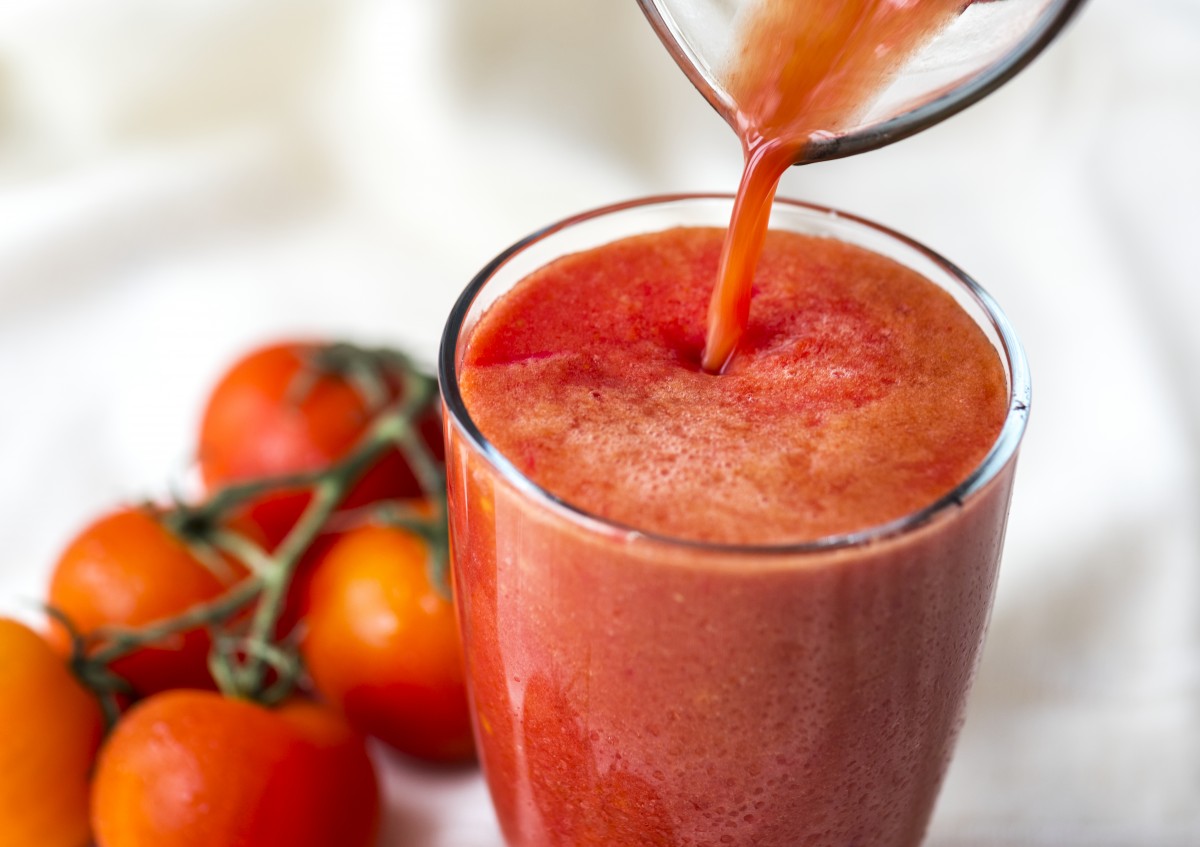Tomato juice is one of the easiest and most accessible home preparations. It’s also one of the tastiest and healthiest. We list all the advantages of tomato juice and share ideas on what you can make with it.
Tomatoes are especially tasty in summer and early autumn: sweet, ripe, and juicy. Much depends on the variety, but even inexpensive tomatoes reach their peak flavour and quality. Most often red fruits are added to salads, made into light summer soups, dried, prepared in their own juice. No less noteworthy recipe is tomato juice, one of the easiest options to preserve the benefits and taste of vegetables for the winter. Tomato juice began to be prepared in the USA in 1917 as an alternative to orange juice. After about 20 years, the drink became popular in the Soviet Union.
The benefits of tomato juice
Tomato juice is rich in fiber and vitamins, plus it has few calories, which makes it an important part of a healthy diet. Especially if it has no unnecessary additives – for this reason it is better to make it yourself rather than buy it in the shop.
100 grams of tomato juice with salt contains:
17 kcal
0.9 g protein
0.3 g fats
3.1 g carbohydrates
0,4 g of fibre
However, the drink is great not only for its low calorie content but also for the fact that it retains most of the benefits of fresh tomatoes. Thus, tomato juice is rich in B vitamins (including folic acid), beta-carotene (provitamin A), vitamins C, K, PP and E, plus iron, magnesium, potassium, calcium and other minerals. Tomato juice is recommended to include in the daily diet of people with cardiovascular diseases, high cholesterol, low blood pressure, kidney and metabolic disorders. Of course, it is not a panacea for these diseases, but it is an excellent aid to full medical treatment.
Tomato juice is recommended, if you watch your diet and figure
Do tomato juices have contraindications?
Yes, just like any other product. Tomato juice, like fresh tomatoes, should be treated with caution in case of allergies – to the vegetable itself and, oddly enough, to the pollen, as tomatoes contain similar proteins. In the case of itching, sore throat and other similar symptoms, tomato juice should be avoided or its consumption significantly reduced.
With hyperacidity of the stomach and peptic ulcers, the drink is also not recommended – it can exacerbate the symptoms. This usually manifests as stomach pain and heartburn attacks – signals that should make you reconsider your daily diet. The reason is the antioxidant lycopene in tomatoes.
Tomato juice also contains oxalate salts that can provoke kidney stone formation. However, this does not mean that the drink should be avoided by everyone, including healthy people. This is just a reason to be more careful in the diet of people prone to kidney diseases. No more than that.
Is tomato juice more useful than fresh tomatoes?
The peculiarity of tomato juice is that for its preparation fresh tomatoes must undergo heat treatment. Usually, first the vegetables are ground in a blender or chopped with a meat grinder. The puree is then boiled. This process deprives tomato juice of 90% of its vitamin C, but strangely enough it still makes it healthier than regular tomatoes.
The fact is that cooking increases the content of lycopene, a natural antioxidant that makes most tomato varieties have a beautiful red color. In addition, lycopene is able to fight free radicals in the body (which is necessary for us to feel healthy and young) and also protects against cardiovascular diseases and cholesterol accumulation. So in terms of health care, tomato juice is an excellent product, even though it lacks vitamin C (which, by the way, is plentiful in other fruits and vegetables that we usually eat fresh).
Also heat treatment transfers fiber and vitamin A to a more accessible form for the human body. To enhance the benefits, vegetables with beta-carotene are recommended to be eaten together with fats such as vegetable oil, sour cream or cream. Tomato juice contains nothing of the sort, but you can drink it as a supplement to your main meal, for example. This way you don’t have to whip up an already well-balanced recipe.
By the way, tomatoes are not the only product that becomes healthier after heat treatment. We wrote about this here.
Which tomato juice is really healthy
The surest way to get the healthiest tomato juice is to make it yourself. This way, you can control every step: choose the most beautiful and aromatic tomatoes at the market or in the shop, or, for example, use tomatoes grown in your own garden and add only the spices you like. When making tomato juice, salt and sugar are usually used to enhance the flavor. Their amount can be adjusted according to personal preference. Or avoid them altogether and add, for example, ground pepper to make a healthy but not bland drink.
It’s more complicated with store-bought tomato juices. The fact is that nowadays mostly reconstituted juices are on sale, and they are usually made from tomato paste that has undergone a long industrial process. The raw material is then diluted with water and refined with large quantities of salt and sugar, until it tastes just right. It is almost impossible to tell the quality of the paste and the amount of spices used from the information on the label. In this case, it is better to trust a trusted producer or to prefer a juice made from tomato puree rather than paste.
How to make tomato juice at home
To get a tasty tomato juice, it is important to know one important rule: tomatoes must be ripe and juicy. The tastier the vegetables themselves, the less salt and sugar they will need. For about 3.5 liters of tomato juice you will need 5 kg of very ripe tomatoes of any kind (but preferably red ones), 35-40 g of salt and 50-55 g of sugar (or to taste). Preparatory stage: the vegetables need to be washed, dried, cut into quarters, and removed from the stalks. Then chop with a meat grinder or blender into a smooth purée. Bring it to the boil, then reduce the heat to medium-low and cook for 12-15 minutes, stirring from time to time. It is not necessary to skim off the foam. Remaining only to rub the juice through a sieve, so that the finished drink did not get the seeds and rind, and then you can store it just in the refrigerator or store for the winter, pouring into sterilized bottles.
Tomato juice is easy to make at home from any type of tomato
Find more information about the recipe here.
Cocktail and drink ideas with tomato juice
The first thing that usually comes to mind is the classic Bloody Mary cocktail. It’s made with one part vodka and one part tomato juice, flavored with black pepper, a few drops of Tabasco and Worcester sauce and salt. You can use a celery stalk for serving – it’s more aesthetically pleasing and tasty. For those who don’t like strong cocktails, you can adjust the proportions of ingredients to suit your tastes.
Another popular cocktail is the sangrita, which contains no alcohol at all. In Mexico, it is used with tequila, but it can also be served without it because it has a sweet and sour taste with a spicy kick to the appetite. To make a sangrita, mix 2 parts tomato juice with 1 part orange juice, add a spoonful of lime juice and season with salt and hot tabasco sauce. Some recipes also add Worcester sauce and brown sugar, and sometimes the “degree” of the cocktail is raised with tequila, although this is not quite right. Sangrita is best served with seafood, such as grilled prawns, or paella.
Tomato juice can also be drunk simply with celery, or mixed with other vegetable juices: beetroot, carrot, pumpkin. A particularly interesting combination is made by mixing tomato and carrot juice with coconut cream. Plus, it’s quite beneficial: the fatty, plant-based drink will greatly increase the absorption of vitamin A.

